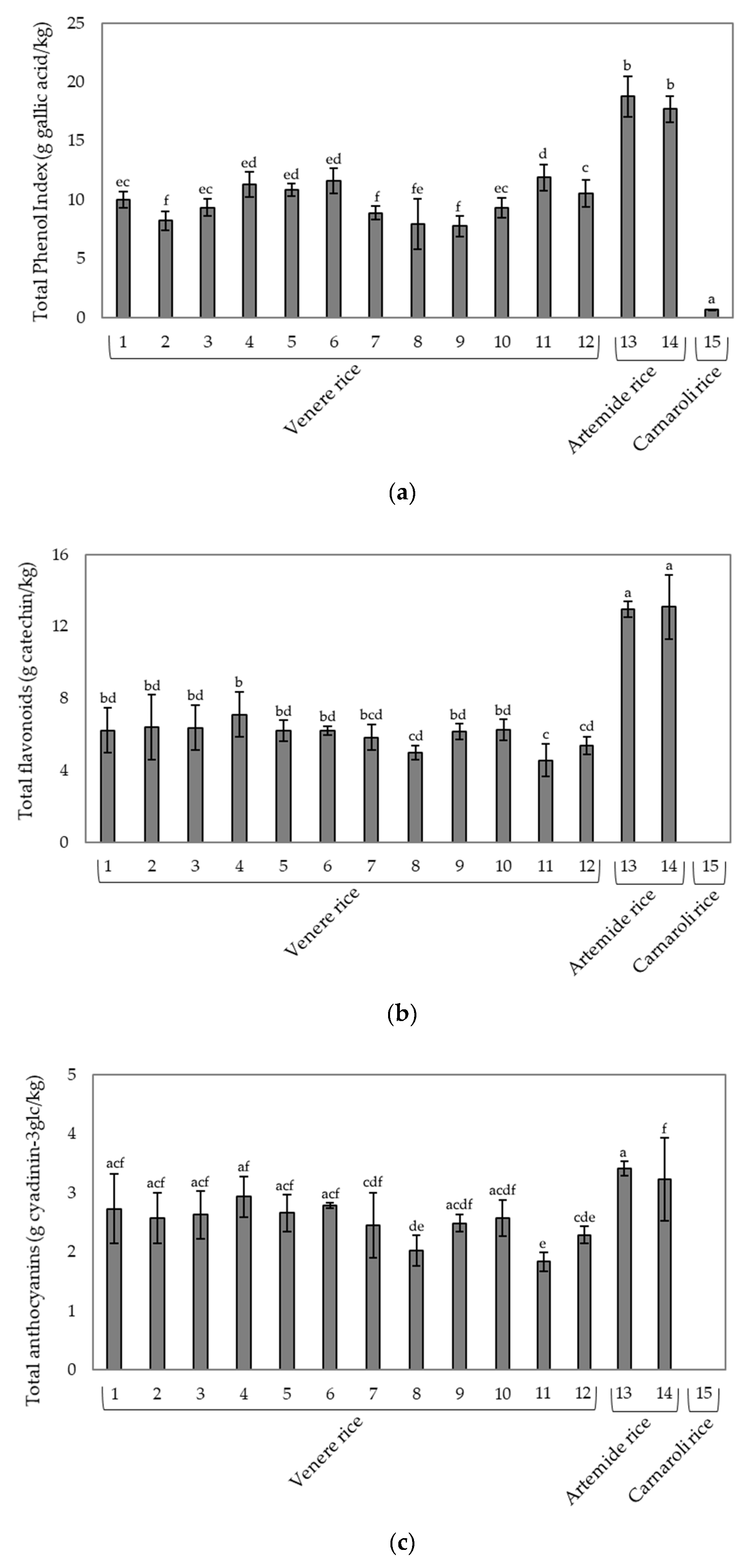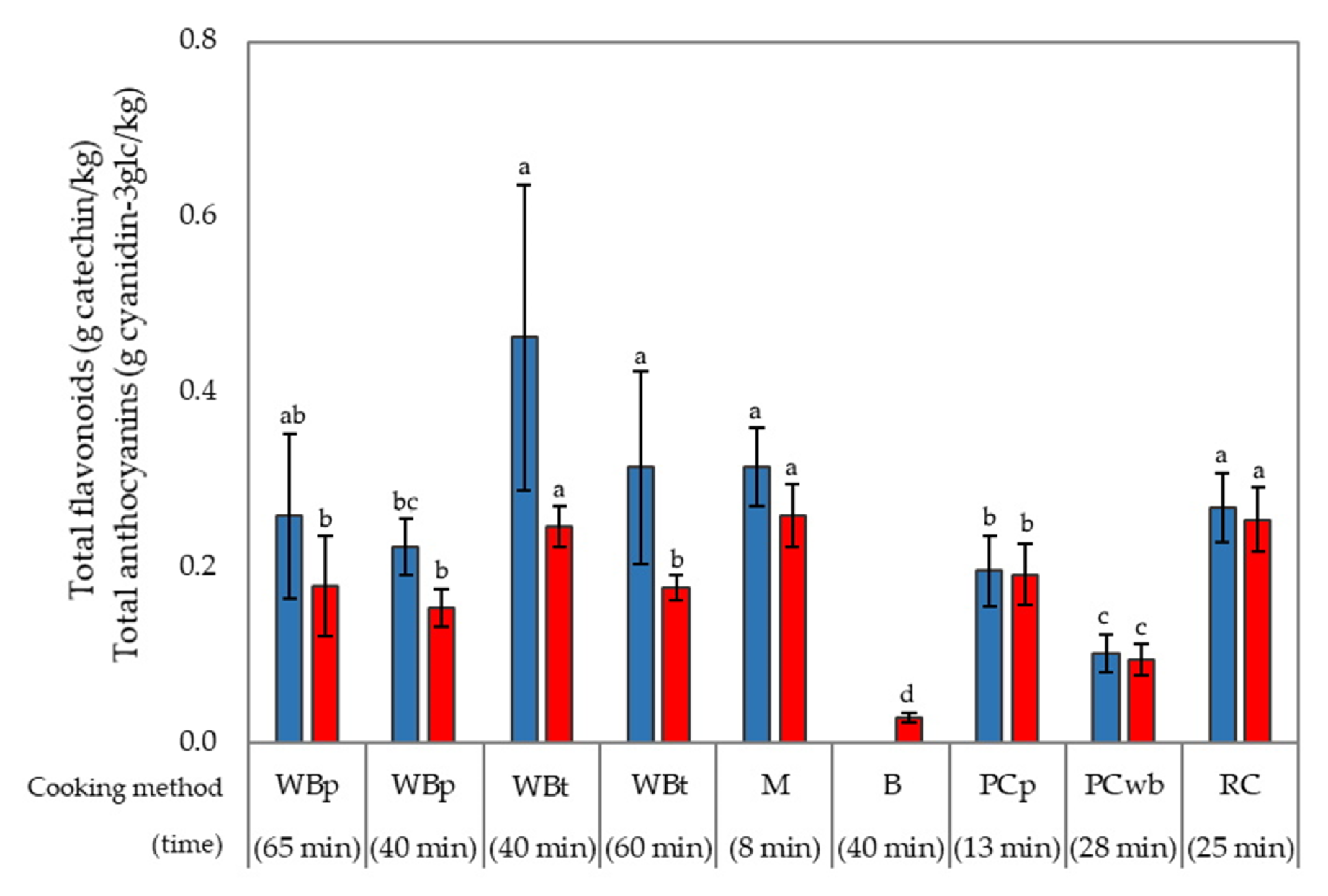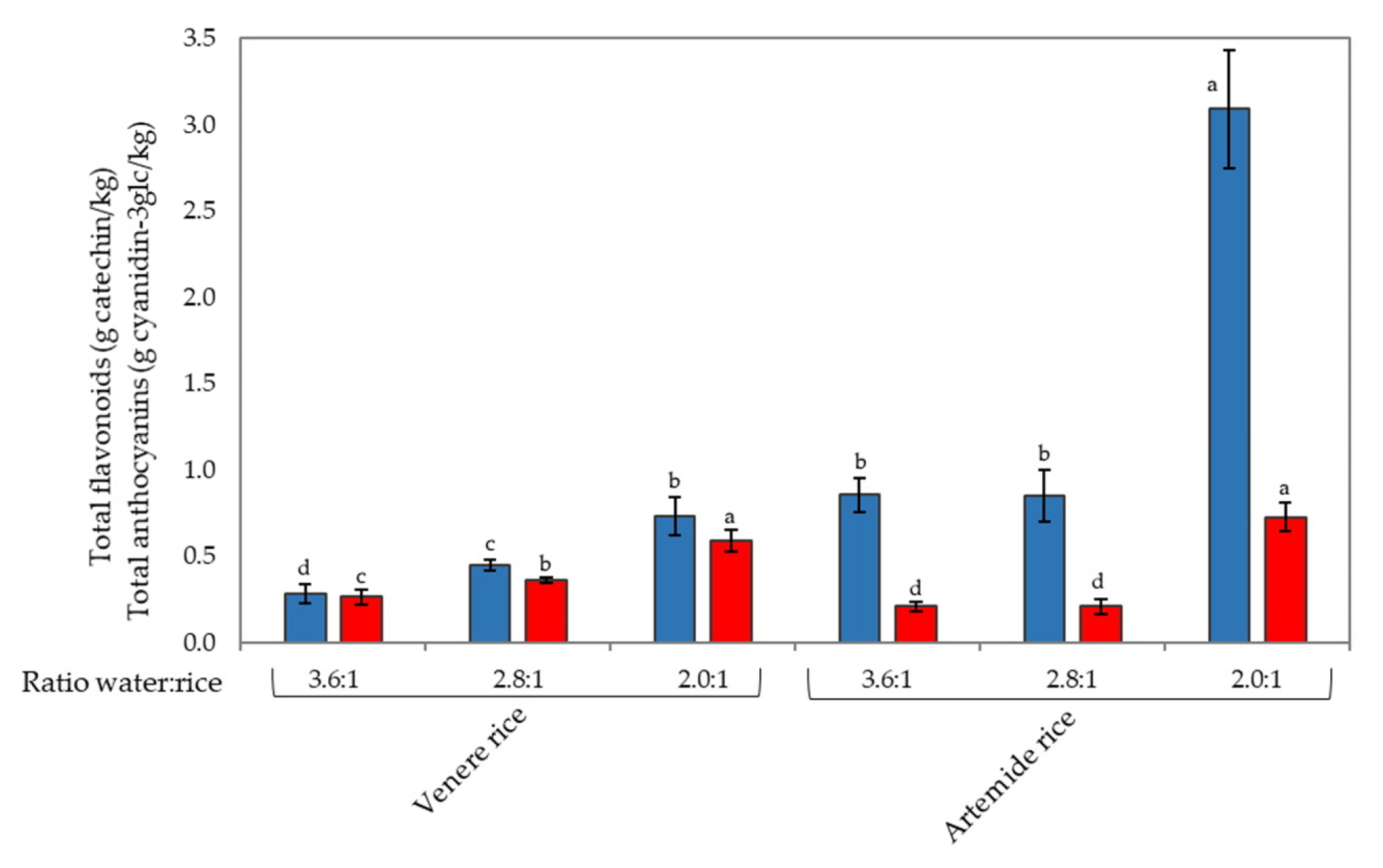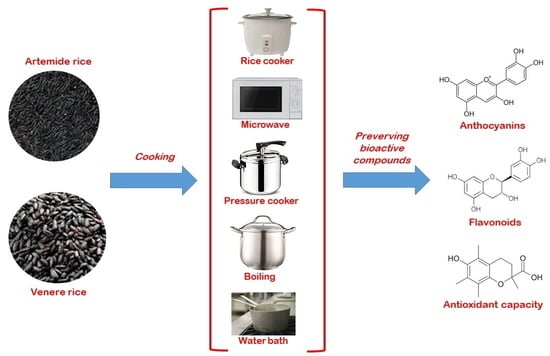Impact of Cooking on Bioactive Compounds and Antioxidant Activity of Pigmented Rice Cultivars
Abstract
1. Introduction
2. Materials and Methods
2.1. Chemicals and Reagents
2.2. Rice Cultivars
2.3. Sample Preparation
2.4. Extraction Procedure
2.5. Determination of Phenolic Compounds
2.6. Determination of Antioxidant Activity
2.7. Statistical Analysis
3. Results and Discussion
3.1. Bioactive Compounds and Antioxidant Capacity of Pigmented Rice Cultivars
3.2. Effect of Cooking on Bioactive Compounds and Antioxidant Capacity
4. Conclusions
Author Contributions
Funding
Acknowledgments
Conflicts of Interest
References
- Chaudhary, R.C. Speciality rices of the world: Effect of WTO and IPR on its production trend and marketing. J. Food Agric. Environ. 2003, 1, 34–41. [Google Scholar]
- Renger, A.; Steinhart, H. Ferulic acid dehydrodimers as structural elements in cereal dietary fibre. Eur. Food Res. Technol. 2000, 211, 422–428. [Google Scholar] [CrossRef]
- Delgado-Vargas, F.; Jimenez, A.R.; Paredes-López, O. Natural pigments: Carotenoids, anthocyanins, and betalains—Characteristics, biosynthesis, processing, and stability. Crit. Rev. Food Sci. Nutr. 2000, 40, 173–289. [Google Scholar] [CrossRef] [PubMed]
- Finocchiaro, F.; Ferrari, B.; Gianinetti, A.; Dall’Asta, C.; Galaverna, G.; Scazzina, F.; Pellegrini, N. Characterization of antioxidant compounds of red and white rice and changes in total antioxidant capacity during processing. Mol. Nutr. Food Res. 2007, 51, 1006–1019. [Google Scholar] [CrossRef] [PubMed]
- Bordiga, M.; Gómez-Alonso, S.; Locatelli, M.; Travaglia, F.; Coisson, J.D.; Hermosín-Gutiérrez, I.; Arlorio, M. Phenolics characterization and antioxidant activity of six different pigmented Oryza sativa L. cultivars grown in Piedmont (Italy). Food Res. Int. 2014, 65, 282–290. [Google Scholar] [CrossRef]
- Zaupa, M.; Calani, L.; Del Rio, D.; Brighenti, F.; Pellegrini, N. Characterization of total antioxidant capacity and (poly)phenolic compounds of differently pigmented rice varieties and their changes during domestic cooking. Food Chem. 2015, 187, 338–347. [Google Scholar] [CrossRef]
- Chen, Q.; Ling, W.; Ma, J.; Mei, J. Effects of black and red rice on the formation of aortic plaques and blood lipids in rabbits. J. Hyg. Res. 2000, 29, 170–172. [Google Scholar]
- Ling, W.H.; Cheng, Q.X.; Ma, J.; Wang, T. Red and black rice decrease atherosclerotic plaque formation and increase antioxidant status in rabbits. J. Nutr. 2001, 131, 1421–1426. [Google Scholar] [CrossRef]
- Ling, W.H.; Wang, L.L.; Ma, J. Supplementation of the black rice outer layer fraction to rabbits decreases atherosclerotic plaque formation and increases antioxidant status. J. Nutr. 2002, 132, 20–26. [Google Scholar] [CrossRef]
- Boue, S.M.; Daigle, K.W.; Chen, M.-H.; Cao, H.; Heiman, M. Antidiabetic potential of purple and red rice (Oryza sativa L.) bran extracts. J. Agric. Food Chem. 2016, 64, 5345–5353. [Google Scholar] [CrossRef]
- Surh, J.; Koh, E. Effects of four different cooking methods on anthocyanins, total phenolics and antioxidant activity of black rice. J. Sci. Food Agric. 2014, 94, 3296–3304. [Google Scholar] [CrossRef] [PubMed]
- Hiemori, M.; Koh, E.; Mitchell, A.E. Influence of cooking on anthocyanins in black rice (Oryza sativaL.japonicavar. SBR). J. Agric. Food Chem. 2009, 57, 1908–1914. [Google Scholar] [CrossRef] [PubMed]
- Tang, Y.; Cai, W.; Xu, B. From rice bag to table: Fate of phenolic chemical compositions and antioxidant activities in waxy and non-waxy black rice during home cooking. Food Chem. 2016, 191, 81–90. [Google Scholar] [CrossRef] [PubMed]
- Melini, V.; Acquistucci, R. Health-promoting compounds in pigmented Thai and wild rice. Foods 2017, 6, 9. [Google Scholar] [CrossRef] [PubMed]
- Min, B.; McClung, A.; Chen, M. Effects of hydrothermal processes on antioxidants in brown, purple and red bran whole grain rice (Oryza sativa L.). Food Chem. 2014, 159, 106–115. [Google Scholar] [CrossRef] [PubMed]
- Abdel-Aal, E.-S.M.; Hucl, P. Composition and stability of anthocyanins in blue-grained wheat. J. Agric. Food Chem. 2003, 51, 2174–2180. [Google Scholar] [CrossRef]
- Towo, E.E.; Svanberg, U.; Ndossi, G.D. Effect of grain pre-treatment on different extractable phenolic groups in cereals and legumes commonly consumed in Tanzania. J. Sci. Food Agric. 2003, 83, 980–986. [Google Scholar] [CrossRef]
- Scalbert, A.; Monties, B.; Janin, G. Tannins in wood: Comparison of different estimation methods. J. Agric. Food Chem. 1989, 37, 1324–1329. [Google Scholar] [CrossRef]
- Di Stefano, R.; Cravero, M.C.; Gentilini, N. Metodi per lo studio dei polifenoli dei vini. L’Enotecnico 1989, 25, 83–89. [Google Scholar]
- Fracassetti, D.; Gabrielli, M.; Costa, C.; Tomás-Barberán, F.A.; Tirelli, A. Characterization and suitability of polyphenols-based formulas to replace sulfur dioxide for storage of sparkling white wine. Food Control 2016, 60, 606–614. [Google Scholar] [CrossRef]
- Brand-Williams, W.; Cuvelier, M.; Berset, C. Use of a free radical method to evaluate antioxidant activity. LWT 1995, 28, 25–30. [Google Scholar] [CrossRef]
- Vitalini, S.; Gardana, C.; Simonetti, P.; Fico, G.; Iriti, M. Melatonin, melatonin isomers and stilbenes in Italian traditional grape products and their antiradical capacity. J. Pineal Res. 2012, 54, 322–333. [Google Scholar] [CrossRef]
- Kong, C.; Xu, X.; Zhou, B.; Hu, F.; Zhang, C.; Zhang, M. Two compounds from allelopathic rice accession and their inhibitory activity on weeds and fungal pathogens. Phytochemistry 2004, 65, 1123–1128. [Google Scholar] [CrossRef] [PubMed]
- Park, H.L.; Lee, S.-W.; Jung, K.-H.; Hahn, T.-R.; Cho, M.-H. Transcriptomic analysis of UV-treated rice leaves reveals UV-induced phytoalexin biosynthetic pathways and their regulatory networks in rice. Phytochemistry 2013, 96, 57–71. [Google Scholar] [CrossRef] [PubMed]
- Soto-Vaca, A.; Gutierrez, A.; Losso, J.N.; Xu, Z.; Finley, J.W. Evolution of phenolic compounds from color and flavor problems to health benefits. J. Agric. Food Chem. 2012, 60, 6658–6677. [Google Scholar] [CrossRef]
- Ogo, Y.; Mori, T.; Nakabayashi, R.; Saito, K.; Takaiwa, F. Transgenic rice seed expressing flavonoid biosynthetic genes accumulate glycosylated and/or acylated flavonoids in protein bodies. J. Exp. Bot. 2015, 67, 95–106. [Google Scholar] [CrossRef] [PubMed]
- Hu, C.; Zawistowski, J.; Ling, W.; Kitts, D.D. Black rice (Oryza sativaL.indica) pigmented fraction suppresses both reactive oxygen species and nitric oxide in chemical and biological model systems. J. Agric. Food Chem. 2003, 51, 5271–5277. [Google Scholar] [CrossRef]
- Tian, Q.; Giusti, M.M.; Stoner, G.D.; Schwartz, S.J. Screening for anthocyanins using high-performance liquid chromatography coupled to electrospray ionization tandem mass spectrometry with precursor-ion analysis, product-ion analysis, common-neutral-loss analysis, and selected reaction monitoring. J. Chromatogr. A 2005, 1091, 72–82. [Google Scholar] [CrossRef]
- Bagchi, D.; Garg, A.; Krohn, R.L.; Bagchi, M.; Balmoori, J.; Stohs, S.J.; Bagchi, D.J.; Bagchi, D. Protective effects of grape seed Proanthocyanidins and selected antioxidants against TPA-induced hepatic and brain lipid peroxidation and DNA fragmentation, and peritoneal macrophage activation in mice. Gen. Pharmacol. Vasc. Syst. 1998, 30, 771–776. [Google Scholar] [CrossRef]
- Chen, Z.; Chan, P.; Ho, K.; Fung, K.-P.; Wang, J. Antioxidant activity of natural flavonoids is governed by number and location of their aromatic hydroxyl groups. Chem. Phys. Lipids 1996, 79, 157–163. [Google Scholar] [CrossRef]
- Rice-Evans, C.A.; Miller, N.J.; Paganga, G. Structure-antioxidant activity relationships of flavonoids and phenolic acids. Free. Radic. Boil. Med. 1996, 20, 933–956. [Google Scholar] [CrossRef]
- Yamuangmorn, S.; Dell, B.; Prom-U-Thai, C. Effects of Cooking on Anthocyanin Concentration and Bioactive Antioxidant Capacity in Glutinous and Non-Glutinous Purple Rice. Rice Sci. 2018, 25, 270–278. [Google Scholar] [CrossRef]
- Prior, R.L.; Wu, X.; Schaich, K. Standardized methods for the determination of antioxidant capacity and Phenolics in foods and dietary supplements. J. Agric. Food Chem. 2005, 53, 4290–4302. [Google Scholar] [CrossRef] [PubMed]
- Varoni, E.M.; Vitalini, S.; Contino, D.; Lodi, G.; Simonetti, P.; Gardana, C.; Sardella, A.; Carrassi, A.; Iriti, M. Effects of red wine intake on human salivary antiradical capacity and total polyphenol content. Food Chem. Toxicol. 2013, 58, 289–294. [Google Scholar] [CrossRef] [PubMed]
- Chmiel, T.; Saputro, I.E.; Kusznierewicz, B.; Bartoszek, A. The impact of cooking method on the phenolic composition, total antioxidant activity and starch digestibility of rice (Oryza sativa L.). J. Food Process. Preserv. 2017, 42, e13383. [Google Scholar] [CrossRef]
- Thuengtung, S.; Ogawa, Y. Comparative study of conventional steam cooking and microwave cooking on cooked pigmented rice texture and their phenolic antioxidant. Food Sci. Nutr. 2020, 8, 965–972. [Google Scholar] [CrossRef]
- Sebastian, R.S.; Enns, C.W.; Goldman, J.D.; Martin, C.L.; Steinfeldt, L.C.; Murayi, T.; Moshfegh, A.J. A new database facilitates characterization of flavonoid intake, sources, and positive associations with diet quality among US adults. J. Nutr. 2015, 145, 1239–1248. [Google Scholar] [CrossRef]
- Chinese Nutrition Society. Chinese DRIs Handbook; Standards Press of China: Beijing, China, 2013. [Google Scholar]




| Cooking Method | Procedure | Time (min) | Water:Rice Ratio (v/w) | Reference |
|---|---|---|---|---|
| Boiling | 100 g rice sample was placed in a pot with boiling water | 40 | 20:1 | [11] |
| Microwave | 100 g rice sample was placed in a microwave container, added with water | 8 | 2:1 | [18] |
| Pressure cooker | Pilaf method: 100 g rice sample was placed in a pressure pot and covered with water | 13 | 2:1 | [12] |
| Water bath (bain–marie method): 100 g rice sample and water were added to a glass container, placed in a pressure pot with water bath | 28 | 2:1 | ||
| Water bath | 100 g rice sample was added with water in a glass container, capped and placed in a water bath (100 °C). The sample was cooked until it reached complete absorption of water, stirring every 10 min | 40–65 |
| [6] |
| 120 mg rice sample was added with water in a glass container, capped and placed in a water bath (100 °C). Cooking method labeled as “laboratory condition”. | 40 | 2:1 | ||
| Rice cooker | 500 g rice sample was placed in a rice cooker and added with water | 25 | 2:1 | [15] |
| Sample. | Total Phenol Index (g gallic acid/kg) | Total Flavonoids (g catechin/kg) | Total Anthocyanins (g Cy-3glc/kg) | Antioxidant Activity | ||
|---|---|---|---|---|---|---|
| DPPH (mM Trolox/kg) | ABTS (mM Trolox/kg) | |||||
| Carnaroli | Raw | 0.65 ± 0.05 e | n.d. | n.d. | 1.43 ± 0.76 e | 0.12 ± 0.00 f |
| Cooked | 0.44 ± 0.03 a (−31.7 ± 0.5) | n.d. | n.d. | 3.4 ± 2.2 a (58.5 ± 8.4) | 0.12 ± 0.01 a (no difference) | |
| Venere | Raw | 11.61 ± 1.06 d | 6.20 ± 0.26 d | 2.78 ± 0.04 d | 31.42 ± 3.08 d | 1.21 ± 0.08 e |
| Cooked | 4.83 ± 0.7 b (−58.3 ± 3.0) | 1.69 ± 0.29 a (−72.8 ± 3.5) | 1.14 ± 0.16 a (−59.1 ± 5.2) | 44.3 ± 2.5 b (40.9 ± 5.9) | 0.71 ± 0.02 b (−41.3 ± 2.2) | |
| Artemide | Raw | 18.76 ± 1.71 c | 12.96 ± 0.44 c | 3.41 ± 0.12 c | 46.64 ± 6.72 b | 2.80 ± 0.16 d |
| Cooked | 5.31 ± 0.27 b (−71.7 ± 1.2) | 5.97 ± 0.75 b (−53.9 ± 4.2) | 1.76 ± 0.24 b (−48.2 ± 5.2) | 68.3 ± 4.0 c (46.5 ± 12.8) | 1.11 ± 0.06 c (−60.4 ± 0.1) | |
| Sample | Cooking Method | Total Phenol Index (g gallic acid) | Total Flavonoids (g catechin) | Total Anthocyanins (g Cy-3glc) | Antioxidant Activity | ||
|---|---|---|---|---|---|---|---|
| DPPH (mM Trolox) | ABTS (mM Trolox) | ||||||
| Carnaroli | Raw samples | 0.65 ± 0.05 g | n.d. | n.d. | 1.43 ± 0.76 e | 0.12 ± 0.00 f | |
| Water bath | Rice | 0.08 ± 0.00 a | n.d. | n.d. | n.d. | 0.09 ± 0.00 a | |
| Rice cooker | Rice | 0.14 ± 0.01 b | n.d | n.d. | n.d. | 0.01 ± 0.00 a | |
| Water | n.d. | n.d | n.d. | n.d. | n.d. | ||
| Venere | Raw samples | 11.61 ± 1.06 e | 6.20 ± 0.26 d | 2.78 ± 0.04 b | 31.42 ± 3.08 c | 1.21 ± 0.08 b | |
| Water bath | Rice | 0.85 ± 0.07 c | 0.46 ± 0.08 a | 0.35 ± 0.07 a | 0.66 ± 0.09 a | 0.78 ± 0.03 b | |
| Rice cooker | Rice | 0.86 ± 0.06 c | 0.27 ± 0.04 b | 0.26 ± 0.04 a | 0.77 ± 0.30 a | 0.29 ± 0.00 d | |
| Water | 3.34 ± 0.24 A | 2.17 ± 0.08 A | 7.55 ± 0.40 A | 6.07 ± 0.52 A | 23.62 ± 0.74 A | ||
| Artemide | Raw samples | 18.76 ± 1.71 f | 12.96 ± 0.44 e | 3.41 ± 0.12 b | 46.64 ± 6.72 d | 2.80 ± 0.16 d | |
| Water bath | Rice | 0.78 ± 0.10 c | 1.00 ± 0.27 b | 0.31 ± 0.07 a | 0.80 ± 0.12 a | 1.05 ± 0.02 b | |
| Rice cooker | Rice | 2.58 ± 0.29 d | 1.30 ± 0.13 c | 0.35 ± 0.07 a | 5.41 ± 0.75 b | 0.41 ± 0.02 c | |
| Water | 4.62 ± 0.52 B | 4.58 ± 0.11 B | 8.11 ± 0.20 A | 22.07 ± 4.20 B | 66.38 ± 5.34 B | ||
© 2020 by the authors. Licensee MDPI, Basel, Switzerland. This article is an open access article distributed under the terms and conditions of the Creative Commons Attribution (CC BY) license (http://creativecommons.org/licenses/by/4.0/).
Share and Cite
Fracassetti, D.; Pozzoli, C.; Vitalini, S.; Tirelli, A.; Iriti, M. Impact of Cooking on Bioactive Compounds and Antioxidant Activity of Pigmented Rice Cultivars. Foods 2020, 9, 967. https://doi.org/10.3390/foods9080967
Fracassetti D, Pozzoli C, Vitalini S, Tirelli A, Iriti M. Impact of Cooking on Bioactive Compounds and Antioxidant Activity of Pigmented Rice Cultivars. Foods. 2020; 9(8):967. https://doi.org/10.3390/foods9080967
Chicago/Turabian StyleFracassetti, Daniela, Carola Pozzoli, Sara Vitalini, Antonio Tirelli, and Marcello Iriti. 2020. "Impact of Cooking on Bioactive Compounds and Antioxidant Activity of Pigmented Rice Cultivars" Foods 9, no. 8: 967. https://doi.org/10.3390/foods9080967
APA StyleFracassetti, D., Pozzoli, C., Vitalini, S., Tirelli, A., & Iriti, M. (2020). Impact of Cooking on Bioactive Compounds and Antioxidant Activity of Pigmented Rice Cultivars. Foods, 9(8), 967. https://doi.org/10.3390/foods9080967








